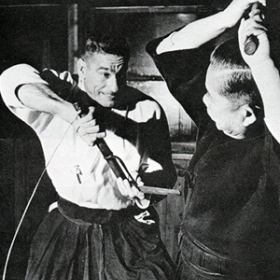|
Training is about epiphanies. Always there is the caution, that an insight might actually take one off-course. What student of Japanese budo, hasn't been told endless times about hips (koshii)?!!! Often, we build a construct about sinking the center of gravity, hip rotation and sometimes the teacher, perhaps with some frustration, places hands on our hips to help us understand.
Imagine my surprise, when after so many years of trying to assist my own students, that the epiphany, which to me, seemed quite obvious, was communicated with a new variation on the theme and light bulbs flashed on, all over the mat! I was asking folks to think about the ball joints in their hips and when to compress and roll like the coiling and uncoiling of a spring - and this was news! Oh, my incompetencies aside, until this point, everyone kept thinking about their "hips" as if the gluteus maximus needed to rotate around the body. Well, my dojo mates might've thought this was mana from heaven but I remain mystified. With Shinnenkai, I'll be looking to see if anything really revolutionary jumps out at me, when we get on the mat. Learning ancient traditions, born of foreign cultures, communicated thru the prism of the Japanese language, and what we take for granted with translation is all part of the fun I guess. Let's see what more time on the mat reveals...
0 Comments
I have often been party and witness to breakdowns in communication involving Japanese. Sometimes culture can defy the best intentions of language.
I’m not suggesting that confusion only takes place between Japanese and Westerners but at the risk of sounding cliche' it is a target rich environment. Yuri related a story to me that received wide coverage in Japan. It is about a Japanese teacher of Haiku living in France and working with French students. Upon completing an assignment to compose haiku, the teacher observed that the students were inserting themselves into their work. One of the in-transmutable rules of this art form is that the individual is not part of the natural scene. The word "I" or "me" doesn't exist and isn't used. The teacher went to great lengths to correct the class about this haiku rule and was acknowledged with a firm and clear, "hai, wakarimasu", or yes it is understood. It appeared to be a good day for greater cultural understanding and the assignment was reissued by the teacher to her students. You can imagine her dismay when the word "my" was inserted for "I". So much so, that she wrote her story for syndication in Japan. Maybe, the students still didn’t really understand despite both their desires to do so and the teacher's desire to teach proper form? In our dojo, despite the advantages of a native speaker of Japanese to serve as translator, and I'll add one with decades of mat time, translating for some of Japan's most prominent teachers, a maxim evolved that basically could be understood to mean that even the easiest concepts to a long time to interpret. Word for word translation would as often as not, be unsuccessful. I can still remember various sensei clearly stating that the feet should be placed "shoulder width apart". it doesn't seem difficult but it added to frustration for teacher and student alike. For the Japanese, it is obvious that the instruction meant that the feet would be located directly under the armpits. Therefore our stances were always a bit too wide! I would imagine, that in reading this it would be easy to believe and dismiss this failure in communication. In retrospect, it would be easy to identify and correct the misconception. In reality, the confusion lasted for years! Hai, wakarimasu Sensei! |
AuthorWrite something about yourself. No need to be fancy, just an overview. ArchivesCategories |
|
Po Box 232 Severna Park, MD. 21146
|
Copyright © 1996 - 2023

 RSS Feed
RSS Feed






